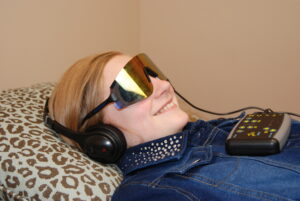Light and Sound Stimulation to Shift the Brain
Light and Sound Stimulation to Shift the Brain
Light and Sound Stimulation to Shift the Brain

Article/Study, December 22, 2022 Psychology Today
KEY POINTS
- Repetitive light and sound can entrain brainwaves.
- Anxiety and stress may be helped with AVE protocols between 7 and 10 Hz.
- Depression, ADHD, and cognitive decline may be helped with AVE protocols between 14 and 18 Hz.
- AVE devices are generally safe and can be used at home as an adjunct to other therapies.
Audio Visual Entrainment or AVE, uses both sound and light stimulation to impact brainwave patterns (Siever & Collura, 2017). Most AVE devices consist of a set of glasses with lights built into the eyesets and headphones. The glasses and headphones are connected to either a small controller box or to the computer. Built-in programs in the software allow you to choose from a variety of settings that will cause the lights in the glasses to flicker on and off at specific frequencies. The tones in the headset will follow the same pattern. Once you choose your program, you sit back, close your eyes and enjoy the show for 15-25 minutes.
The idea is that by providing the brain with a consistent repetitive signal, it will follow along (entrainment). For example, if I chose a relaxation program, the lights might flicker on and off 10 times a second. The brain responds to each of these signals, producing a 10-cycles-per-second brain wave (10 Hz), which is in the alpha frequency range associated with relaxed, internal attention. So, using this technology, you can influence the brain by encouraging it toward certain brainwave patterns, which can influence your state of consciousness.

These devices and their specific programs are generally used for relaxation, to help with sleep, to increase feelings of alertness, to improve mood, or as a treatment option for a wide variety of mental health concerns. For example, many people with anxiety or chronic stress often have an excessive amount of fast brainwave activity (Price & Budzynski, 2009; Olbrich, et al., 2011), causing the mind to be overactive-thinking and worrying more than is helpful. An AVE program to counterbalance this hyperactivity would encourage the brain toward slower brainwaves (7-10 Hz), leading to feeling centered and relaxed. Research using this approach has demonstrated its effectiveness in reducing worry in college students (Wolitzky-Taylor, & Telch, 2010), reducing anxiety during dental procedures (Morse & Chow, 1993; Siever, 2003), and improving sleep (Tang, et al., 2016).
People suffering from depression, ADHD, or cognitive decline often have the opposite challenge. Their brains may be producing an excessive amount of slow brainwaves, causing them to feel tired, unmotivated, inattentive, impulsive, or mentally “foggy” (Fernández-Palleiro, P., 2020; Garcia, et al., 2019; Jeong, 2004). AVE protocols designed to speed the brain up a bit (14-18 Hz) can often help pull the brain out of this pattern, resulting in a feeling of having more energy, optimism, executive function, and self-control. Research using this approach has been shown to improve concentration and memory in college students (Budzynski & Tang, 1998; Budzynski, et al., 1999; 2007; Siever, 2008), as a treatment for ADHD and behavior disorders (Carter & Russell, ,1993; Joyce & Siever, 2000), as a treatment for depression and risk of falling in seniors (Berg & Siever, 2004), and for improving brain function and memory in seniors (Williams, et al., 2006).
AVE technologies are often used as an at-home adjunct to neurofeedback therapy. However, they can also be used to facilitate certain meditations or non-ordinary states of consciousness. For example, some meditations often lead to an increase of brainwaves between 8 and 10 Hz (alpha1). By using an AVE protocol that stimulates 9 Hz activity while you are practicing certain meditation approaches, you can provide a boost to that specific meditative state (Tarrant, 2017). Protocols that regularly shift frequencies and colors or maintain a solid color for an extended time (Ganzfeld) can also be used to induce altered states of consciousness (Wackermann, et al., 2008).
While there is solid research behind this technique, it is important to note that results may vary. Everyone is different and it is impossible to know what approaches may or may not help without an appropriate assessment and some trial and error. The good news is that people tend to notice any change in mood or mental state soon after a session is completed. By experimenting with various protocols, light intensity, time of day, and length of session, it is usually possible to find one or more approaches that help.
References
Berg, K., & Siever, D. (2004). The effect of audio-visual entrainment in depressed community-dwelling senior citizens who fall. Unpublished manuscript. Mind Alive, Inc., Edmonton, Alberta, Canada.
Budzynski, T., Budzynski, H. K., & Tang, H. Y. (2007). Brain brightening: Restoring the aging mind. Handbook of neurofeedback: Dynamics and clinical applications, 231-265.
Budzynski, T., Jordy, J., Budzynski, H. K., Tang, H. Y., & Claypoole, K. (1999). Academic performance enhancement with photic stimulation and EDR feedback. Journal of Neurotherapy, 3(3-4), 11-21.
